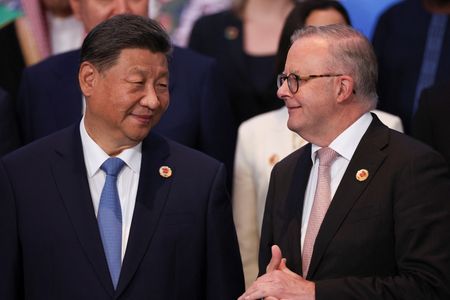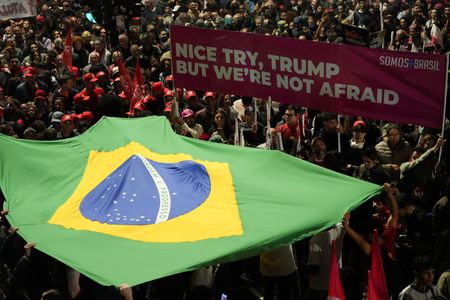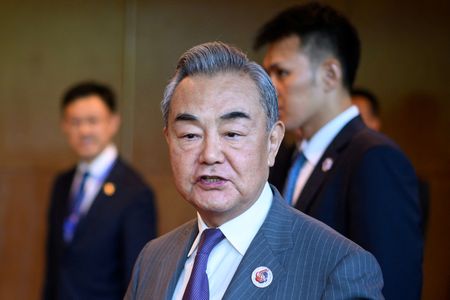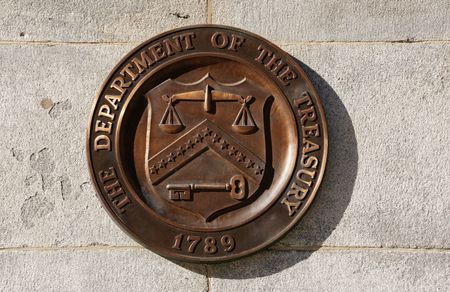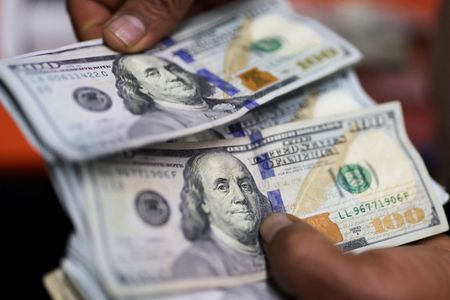By Florence Tan and Nidhi Verma
SINGAPORE/NEW DELHI (Reuters) – Tightened U.S. sanctions on Moscow have disrupted a roaring trade in discounted Russian oil to China and India, reviving demand for Middle Eastern and African crudes, roiling shipping markets and driving up oil prices.
Washington’s January 10 sanctions targeted tankers carrying Russian oil in a push to more effectively limit Moscow’s oil revenue, the aim of western sanctions imposed after its invasion of Ukraine three years ago.
The new rules have left millions of barrels floating on ships and sent traders hunting for alternatives, while dealings in Russian crude, the biggest source for top global importers China and India, have slowed for March.
The scramble has upended market dynamics. For a few weeks, high-sulphur benchmark Dubai became more expensive than low-sulphur Brent, which is easier to process. That opened opportunities for producers from Brazil to Kazakhstan to gain share in China and India.
Premiums for Brazilian crude surged last month to about $5 a barrel against dated Brent on cost and freight basis to China, up from about $2 in the previous month, traders said. That premium is now just below $5 a barrel for May arrival cargoes.
In March, China is set to import its first cargo since June 2024 of Kazakhstan’s CPC Blend, Kpler data showed.
In the week after the new sanctions, TotalEnergies’ trading arm TOTSA received so many enquiries that it held tenders instead of private negotiations to sell its Middle Eastern crude cargoes, which eventually went to China’s CNOOC and Rongsheng Petrochemical, a Singapore-based trader said.
TotalEnergies did not immediately respond to a request for comment.
Reflecting the rush for Middle Eastern crudes, premiums for benchmarks Oman, Dubai and Murban more than doubled in January from December and remain above $3 a barrel to Dubai, despite lower demand from refineries in seasonal maintenance.
In addition, top exporter Saudi Aramco hiked prices for Asia-bound crude to the highest since December 2023, raising costs for refiners.
A seller of Angolan crude said there was an increase in demand from Asian buyers looking to cover.
“Unipec is taking a lot West African crude cargoes, especially Angolan barrels – good buying interest after the Lunar New Year,” a Chinese trader said. Unipec is the trading arm of Asia’s largest refiner Sinopec. Sinopec did not immediately respond to a request for comment.
With sanctioned ships stuck on the water, many traders have rushed to switch to other vessels which now cost multiple times more, adding millions of dollars to the expense of each shipment.
INDIA SCRAMBLES
The rising costs are particularly tough for refiners in India. The country late last year cemented its shift from long-standing Middle Eastern sources to buy more oil from Russia, when Reliance Industries struck a 10-year supply deal with Russian state giant Rosneft worth roughly $13 billion annually.
This week, India’s oil secretary said the country’s refiners want to buy only Russian oil supplied by companies and ships not sanctioned by the U.S. That has effectively reduced the number of cargoes and vessels available, Indian refining sources said.
With a limited supply of sanctions-proof cargoes, discounts for Russian Urals crude to dated Brent have narrowed to $2.50-$2.90 a barrel for March delivery, versus $3-$3.50 before the January sanctions, they said, a major cost increase on a typical one million barrel cargo.
Higher Russian crude costs have narrowed the price gap with Middle East crude to about $3 a barrel from $6-$7 for Indian refiners, offering little incentive to risk incurring secondary sanctions, Indian refining sources said.
Indian buyers turned down offers from Russian shipping giant Sovcomflot to receive payments in any currencies, including Indian rupees, for Russian oil shipped on sanctioned tankers, the sources said, after its CEO met buyers in India on the sidelines of the India Energy Week conference this week. Sovcomflot declined to comment.
The slowdown has meant that Russian oil stored aboard ships has increased by 17 million barrels since January 10, according to a February 5 note from Goldman Sachs, and is expected to rise to 50 million barrels in the first half of 2025.
“We’re seeing floating volume pick up. There’s a number of tankers carrying Russian oil hanging out around Shandong and southern ports in China that are normally not big entry points,” said a senior executive at a major global trading house.
Shandong province is the hub for independent Chinese refiners that have been core buyers of discounted sanctioned oil from Russia as well as Iran and Venezuela.
IRAN’S OUTPUT TARGETED
The Russian supply disruption comes on top of falling Iranian oil imports by top customer China amid tightening U.S. pressure, with President Donald Trump recently vowing to bring Tehran’s oil exports to zero.
Goldman Sachs estimated Iranian floating storage has risen by 14 million barrels since the start of the year to its highest in 14 months. Tighter sanctions enforcement could cut Iran’s output by 1 million barrels per day and push Brent to the high $80s a barrel by May, the analysts said.
The squeeze on cheap crude into China, coupled with weak domestic demand, has led several independent refiners to shut for maintenance instead of losing 500 yuan ($68.62) for every ton of non-sanctioned crude processed based on offers at $7-$8 a barrel above ICE Brent delivered to China, a trader said.
China’s state refiners, meanwhile, are likely to shun Russian oil as sanctions reduce the number of counterparties and insurers for such transactions, while key ports such as Qingdao and Rizhao have become stricter, said a source with knowledge of the matter.
The person estimated Russian export volumes to China would fall by between 700,000 and 800,000 barrels per day from March, after sanctions waivers lapse. That would amount to at least a 70% decline from January, according to Kpler data.
WARNED
Weeks before the sanctions were announced in a 27-page document, Indian refiners were warned by authorities and made some purchases in advance, industry officials said. The Indian government did not respond to a request for comment on whether refiners were warned in advance.
In China, the Shandong Port Group issued a ban three days earlier on sanctioned ships from calling at its ports, although it is not clear whether the move was related.
Other signs that markets were anticipating new measures included higher demand for Middle East and African crude from Chinese and Indian buyers, and a rush to charter ships that subsequently drove up tanker rates sharply, traders said.
Adi Imsirovic, director of consultancy Surrey Clean Energy, and former oil trader at Russia’s Gazprom, said the impact of the sanctions may curb Russian exports by up to 1.5 million barrels per day in the near-term.
“The only true prediction that we can make is that the market is just going to get more volatile. With more and more government intervention in the markets, it’s just going to get more volatile,” he said.
($1 = 7.2870 Chinese yuan renminbi)
(Reporting by Florence Tan in Singapore and Nidhi Verma in New Delhi; additional reporting by Siyi Liu and Chen Aizhu in Singapore, Anna Hirtenstein, Alex Lawler, Ahmad Ghaddar in London; Editing by Tony Munroe and Sonali Paul)


